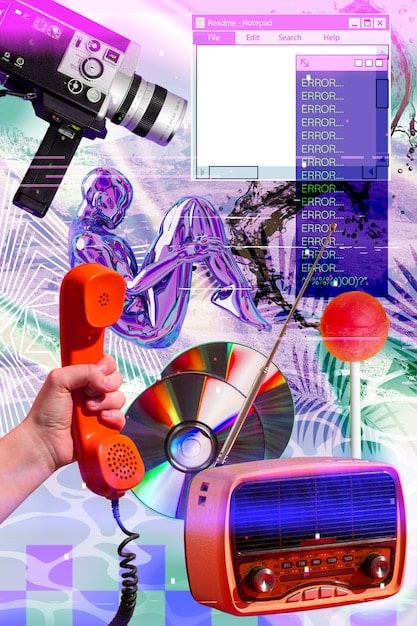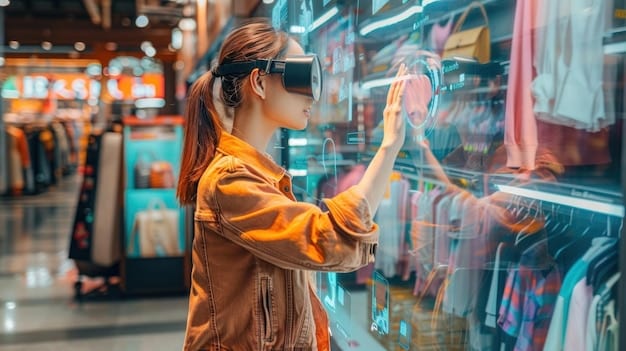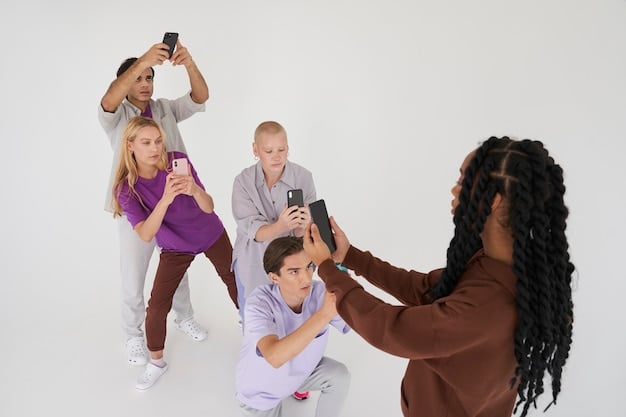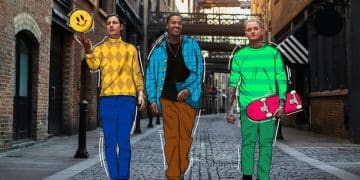The Business of Pop Culture: How Brands Reach Consumers in 2025

The business of pop culture in 2025 revolves around brands strategically leveraging emerging trends in music, film, fashion, and social media to connect authentically with consumers, enhance engagement, and drive sales through innovative marketing approaches.
The landscape of consumer engagement is perpetually shifting, and in 2025, the intertwining of brands with pop culture is set to reach unprecedented levels. This article explores the business of pop culture: how brands are leveraging trends to reach consumers in 2025, examining the innovative strategies and evolving dynamics that shape this powerful intersection.
Understanding the Evolving Landscape of Pop Culture
Pop culture, by its very nature, is dynamic and reflective of societal changes, technological advancements, and evolving consumer tastes. To effectively engage with audiences in 2025, brands must first understand the key forces shaping this ever-changing landscape.
The Rise of Micro-Trends
Traditional trends often had a longer lifespan, but today, micro-trends emerge and dissipate rapidly. This necessitates that brands be agile and quick in identifying and capitalizing on fleeting moments.
The Influence of Gen Z and Alpha
These digitally-native generations are increasingly shaping pop culture. Their values, preferences, and unique communication styles dictate much of what bubbles to the surface of mainstream consciousness.
- Authenticity is Key: Gen Z and Alpha value authenticity above all else. Brands must be genuine in their efforts and avoid appearing opportunistic.
- Digital Natives: These generations have grown up with technology, meaning brands must prioritize digital channels and experiences.
- Social Responsibility: They are highly conscious of social and environmental issues, so brands need to demonstrate a commitment to ethical practices.
Understanding these dynamics lets brands create more meaningful and impactful campaigns. Brands need to be more than just advertisers; they must be active participants in the cultural conversations that matter to their target audiences.
Augmented Reality and Immersive Experiences
One of the most significant trends reshaping brand engagement in 2025 is the rise of augmented reality (AR) and immersive experiences. These technologies offer innovative ways to connect with consumers on a deeper, more interactive level.

Enhancing Retail Experiences
AR allows consumers to virtually try on clothes, visualize furniture in their homes, or explore product features in an engaging way. This enhances the overall shopping experience and drives conversions.
Gamification and Interactive Storytelling
Brands can leverage AR to create interactive games, scavenger hunts, and immersive storytelling experiences that capture consumers’ attention and foster brand loyalty.
- Interactive Ads: AR-powered ads can transform static campaigns into engaging experiences, offering users a chance to interact with the brand in unique ways.
- Virtual Events: Brands can host virtual concerts, fashion shows, and product launches using AR technology, reaching a global audience without the limitations of physical events.
- Personalized Content: AR enables brands to deliver personalized content based on users’ interactions and preferences, enhancing the relevance and impact of their messaging.
Immersive and engaging experiences not only capture the attention of consumers but also create lasting memories that reinforce brand affinity.
The Power of Influencer Marketing
Influencer marketing remains a potent tool for brands looking to tap into pop culture trends and reach specific audiences. However, in 2025, the landscape has evolved, with a greater emphasis on authenticity, diversity, and meaningful partnerships.
Micro-Influencers and Niche Communities
While celebrity endorsements still hold value, brands are increasingly turning to micro-influencers who have built strong relationships with niche communities. Their authenticity and relatability resonate deeply with their followers.
Long-Term Partnerships and Co-Creation
Instead of one-off campaigns, brands are forging long-term partnerships with influencers, co-creating content, and integrating them into their overall marketing strategy. This fosters trust and ensures a more authentic connection with the audience.
Collaborating with influencers on content allows brands to tap into a more genuine and relatable form of advertising. These authentic interactions can lead to deeper engagement and loyalty among consumers.
Social Media and Viral Marketing
Social media platforms continue to be central to pop culture. Brands in 2025 are innovating to create viral marketing campaigns that capture attention, spark conversations, and spread like wildfire across digital networks.

TikTok and Short-Form Video Dominance
TikTok’s short-form video format has revolutionized the way content is consumed and shared. Brands leverage TikTok to create engaging challenges, showcase products, and tap into emerging trends.
Meme Culture and User-Generated Content
Memes have become a universal language on social media. Brands cleverly incorporate memes into their marketing to connect with audiences on a humorous and relatable level.
- Interactive Campaigns: Social media campaigns are becoming increasingly interactive, encouraging users to participate, share their experiences, and co-create content.
- Real-Time Engagement: Brands are expected to respond to trends in real-time, engage in conversations, and provide personalized support via social media channels.
- Livestreaming and Q&A Sessions: Livestreaming offers a direct and authentic way for brands to connect with their audience, answer questions, and build relationships.
By embracing the fast-paced, interactive nature of social media, brands can create high-impact campaigns that resonate with consumers and drive brand awareness.
Sustainability and Ethical Considerations
In 2025, consumers are increasingly prioritizing sustainability and ethical practices. Brands must align their values with these concerns to resonate with audiences and maintain a positive brand image.
Eco-Friendly Products and Packaging
Brands are adopting sustainable materials, reducing waste, and promoting eco-friendly products to appeal to environmentally conscious consumers.
Fair Trade and Ethical Sourcing
Consumers are demanding transparency in supply chains and ethical sourcing practices. Brands that demonstrate a commitment to fair labor practices and sustainable sourcing are rewarded with consumer loyalty.
Adopting sustainable business practices and promoting ethical values allows brands to connect with consumers on a deeper level. This demonstrates a commitment not just to profit, but to the well-being of the planet and its people.
Data Analytics and Personalization
Data analytics plays a vital role in understanding consumer preferences and tailoring marketing messages. In 2025, brands are leveraging data to deliver personalized experiences and hyper-targeted campaigns.
AI-Powered Personalization
AI algorithms analyze vast datasets to predict consumer behavior, enabling brands to deliver personalized recommendations, targeted advertising, and customized content.
Privacy and Transparency
While personalization is powerful, brands need to be transparent about data collection practices and prioritize consumer privacy to maintain trust and avoid backlash.
By harnessing the power of data analytics, brands can gain valuable insights into consumer preferences and behaviors, ultimately delivering more relevant and impactful marketing messages. The key is to balance personalization with privacy, ensuring that consumers feel valued and respected.
| Key Point | Brief Description |
|---|---|
| 🚀 Micro-Trends | Brands must quickly adapt to short-lived trends. |
| 📱 AR Integration | Augmented reality enhances retail and marketing. |
| 🌱 Sustainability | Consumers demand ethical and eco-friendly practices. |
| 🎯 Personalization | AI-driven personalization enhances consumer engagement. |
FAQ
▼
Remaining relevant requires constant monitoring of trends, quick adaptation to micro-trends, and authentic engagement with Gen Z and Alpha through digital channels.
▼
AR enhances retail experiences, offers interactive storytelling, and personalizes content, creating deeper connections with consumers and boosting brand loyalty.
▼
Micro-influencers have built strong relationships within niche communities. Their authenticity and relatability resonate more deeply with their followers, leading to higher engagement.
▼
Brands use TikTok for short-form video challenges, incorporate memes, and engage in real-time conversations to create high-impact campaigns that spread rapidly across social media.
▼
Consumers prioritize sustainability and ethical practices. Brands aligning with these values gain consumer loyalty and maintain a positive image, emphasizing environmental and social responsibility.
Conclusion
As we look toward 2025, the business of pop culture will increasingly be defined by brands that can authentically integrate emerging trends, leverage technology for immersive experiences, and align with consumer values. By understanding these key dynamics, brands can stay ahead of the curve, build stronger relationships with their audiences, and drive meaningful growth.





